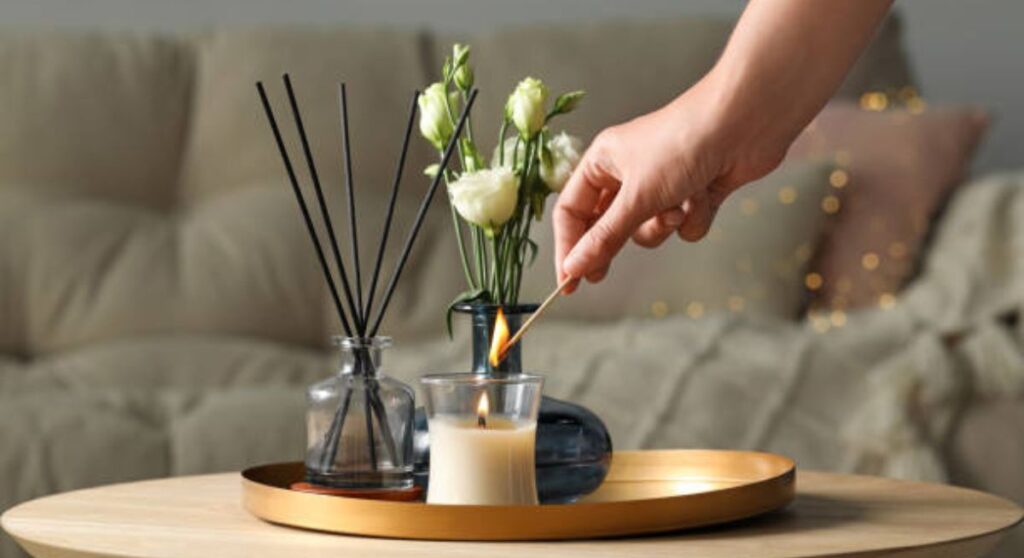Introduction:-
7 Must-Have Scents for DIY Candles and 5 Common Mistakes to Avoid
Homemade scented candles are a fantastic way to create a cozy atmosphere, personalize gifts, and enjoy the benefits of aromatherapy. However, choosing the right scents and avoiding common mistakes can make a significant difference in your candle-making experience. In this guide, we’ll explore seven must-have scents for DIY candles and five common mistakes to steer clear of.
7 Must-Have Scents for DIY Candles

1. Lavender
Lavender is a classic choice known for its calming and stress-relieving properties. Perfect for relaxation and bedtime, lavender-scented candles create a peaceful environment in any space.
2. Vanilla
Warm, comforting, and sweet, vanilla is a timeless scent that enhances coziness. It pairs well with other fragrances like cinnamon, coconut, and coffee for a delightful blend.
3. Citrus (Lemon, Orange, or Grapefruit)
Citrus scents are uplifting, refreshing, and energizing. They are ideal for brightening up your home and enhancing focus and concentration.
4. Peppermint
Known for its invigorating and refreshing qualities, peppermint-scented candles are great for boosting alertness and reducing fatigue.
5. Cinnamon
Cinnamon provides a warm and spicy aroma, making it perfect for fall and winter. It pairs well with vanilla, apple, and clove for a cozy ambiance.
6. Eucalyptus
Eucalyptus offers a crisp, clean scent that promotes relaxation and clear breathing. It’s a great choice for bathrooms and home offices.
7. Sandalwood
Sandalwood is a luxurious, woody scent that creates a soothing and meditative atmosphere. It blends well with floral and spicy notes for a sophisticated touch.
5 Common Mistakes to Avoid When Making Scented Candles

1. Using Too Much or Too Little Fragrance Oil
Adding too much fragrance oil can cause uneven burning, while too little may result in a weak scent throw. The recommended amount is usually 6-10% of the wax weight.
2. Choosing the Wrong Wick Size
The wick size affects how your candle burns. A wick that’s too small can create tunneling, while a wick that’s too large can cause excessive soot and an uneven melt pool.
3. Pouring Wax at the Wrong Temperature
Pouring wax when it’s too hot can lead to fragrance evaporation, while pouring too cool can cause imperfections like sinkholes and frosting. Check the recommended pouring temperature for your wax type.
4. Not Mixing Fragrance Oil Properly
To ensure an even scent distribution, always mix fragrance oil thoroughly into the melted wax at the right temperature (usually between 175-185°F).
5. Skipping the Curing Process
Candles need time to cure for the fragrance to fully develop. Most soy candles require at least 24-48 hours, while paraffin candles can cure in a shorter time.
Tips for Making High-Quality DIY Candles
Making high-quality DIY candles requires attention to detail, the right materials, and proper techniques. Here are some essential tips to ensure your homemade candles look great, burn well, and last long:

1. Choose the Right Wax
- Soy Wax – Burns clean and slow, great for beginners.
- Paraffin Wax – Offers strong scent throw but can release more soot.
- Beeswax – Natural and long-lasting but has a mild honey scent.
- Coconut Wax – Smooth and slow-burning, blends well with other waxes.
2. Use the Right Wick
- Wick size affects how evenly the candle burns.
- Cotton wicks are ideal for clean burning.
- Wood wicks create a crackling effect and work best with soy or coconut wax.
- Test different wicks to find the best fit for your wax and container size.
3. Melt Wax Properly
- Use a double boiler to melt wax evenly and prevent burning.
- Keep the temperature between 170-185°F (77-85°C) for most wax types.
- Avoid overheating, as it can cause discoloration and poor burning quality.
4. Add Fragrance Correctly
- Use high-quality fragrance or essential oils.
- Add fragrance at the correct temperature (usually 170°F for soy wax).
- Use 6-10% fragrance load (per wax weight) for the best scent throw.
5. Choose the Right Container
- Glass, ceramic, and metal containers work best for candles.
- Ensure the container is heat-resistant and clean before pouring wax.
6. Use Proper Dye for Color
- Use candle-safe dyes or natural colorants like mica powder.
- Stir well to distribute color evenly in the wax.
7. Avoid Air Bubbles & Cracks
- Pour wax slowly into the container at the right temperature.
- Pre-warm containers to prevent sinkholes and cracking.
8. Cure Candles for Better Performance
- Let candles cure for at least 24-48 hours before burning.
- Soy candles improve scent throw with 1-2 weeks of curing.
9. Trim the Wick Before Each Use
- Keep wick trimmed to 1/4 inch for a clean, even burn.
- Long wicks can cause excessive smoke and uneven melting.
10. Store Candles Properly
- Keep candles in a cool, dry place away from direct sunlight.
- Cover candles to preserve their scent and color.
Benefits of DIY Scented Candles
DIY scented candles offer numerous benefits, from cost savings to personalized fragrances. Here’s why making your own scented candles is a great idea:
1. Cost-Effective
- Store-bought scented candles can be expensive, but DIY candles are budget-friendly.
- Buying materials in bulk reduces costs even more.
2. Customizable Scents & Colors
- You can create unique fragrance blends using essential or fragrance oils.
- Customize candle colors to match your home décor or mood.
3. Healthier & Non-Toxic
- Store-bought candles often contain synthetic chemicals and paraffin wax, which can release toxins.
- DIY candles allow you to use natural waxes like soy, beeswax, or coconut wax for a cleaner burn.
4. Eco-Friendly
- Choose sustainable waxes and reusable or recyclable containers.
- Avoid synthetic additives and petroleum-based waxes.
5. Therapeutic & Relaxing
- The process of making candles is calming and rewarding.
- Aromatherapy benefits:
- Lavender – Promotes relaxation and sleep.
- Citrus scents – Boosts energy and mood.
- Vanilla & Cinnamon – Creates a cozy atmosphere.
6. Great for Gifting & Selling
- Handmade candles make thoughtful, personalized gifts.
- DIY candles can be a profitable side business if you enjoy crafting.
7. Better Burn Quality
- By choosing the right wick and wax, you can ensure an even and longer-lasting burn.
- No black soot or overpowering artificial scents.
8. Safe for Pets & Kids
- You control the ingredients, avoiding harmful chemicals that may affect sensitive pets and children.
- Use natural fragrances that won’t trigger allergies.
9. Creative & Fun Hobby
- Experiment with different molds, decorations, and layering techniques.
- Express your creativity while making something useful.
Conclusion
Making DIY scented candles is a rewarding and enjoyable hobby that allows you to create custom fragrances while avoiding harmful chemicals found in some store-bought candles. By selecting the right scents and avoiding common mistakes, you can craft high-quality candles that enhance your home’s ambiance and promote well-being.
FAQs
1. What is the best wax for scented candles?
Soy wax is a popular choice due to its clean burn and strong scent throw, but paraffin, coconut, and beeswax are also great options.
2. How long should I let my candles cure before using them?
Soy candles need at least 24-48 hours to cure, while paraffin candles can be used within a few hours.
3. Can I use essential oils instead of fragrance oils?
Yes, but essential oils may not be as strong or long-lasting as fragrance oils in candles.
4. How can I make my candles smell stronger?
Use the recommended fragrance oil percentage (6-10%), mix it at the right temperature, and allow proper curing time.
5. Why is my candle tunneling?
Tunneling occurs when the wick is too small or the candle isn’t burned long enough for the wax to melt evenly.
References
- CandleScience. (2024). “Candle Making Basics.” Retrieved from www.candlescience.com
- The Spruce Crafts. (2024). “How to Make Scented Candles.” Retrieved from www.thesprucecrafts.com
- DIY Candle Makers Forum. (2024). “Tips for Better Scent Throw in Candles.” Retrieved from www.diycandlemakersforum.com
By following these tips and guidelines, you’ll be able to create beautiful, fragrant, and long-lasting homemade candles. Happy candle-making!

